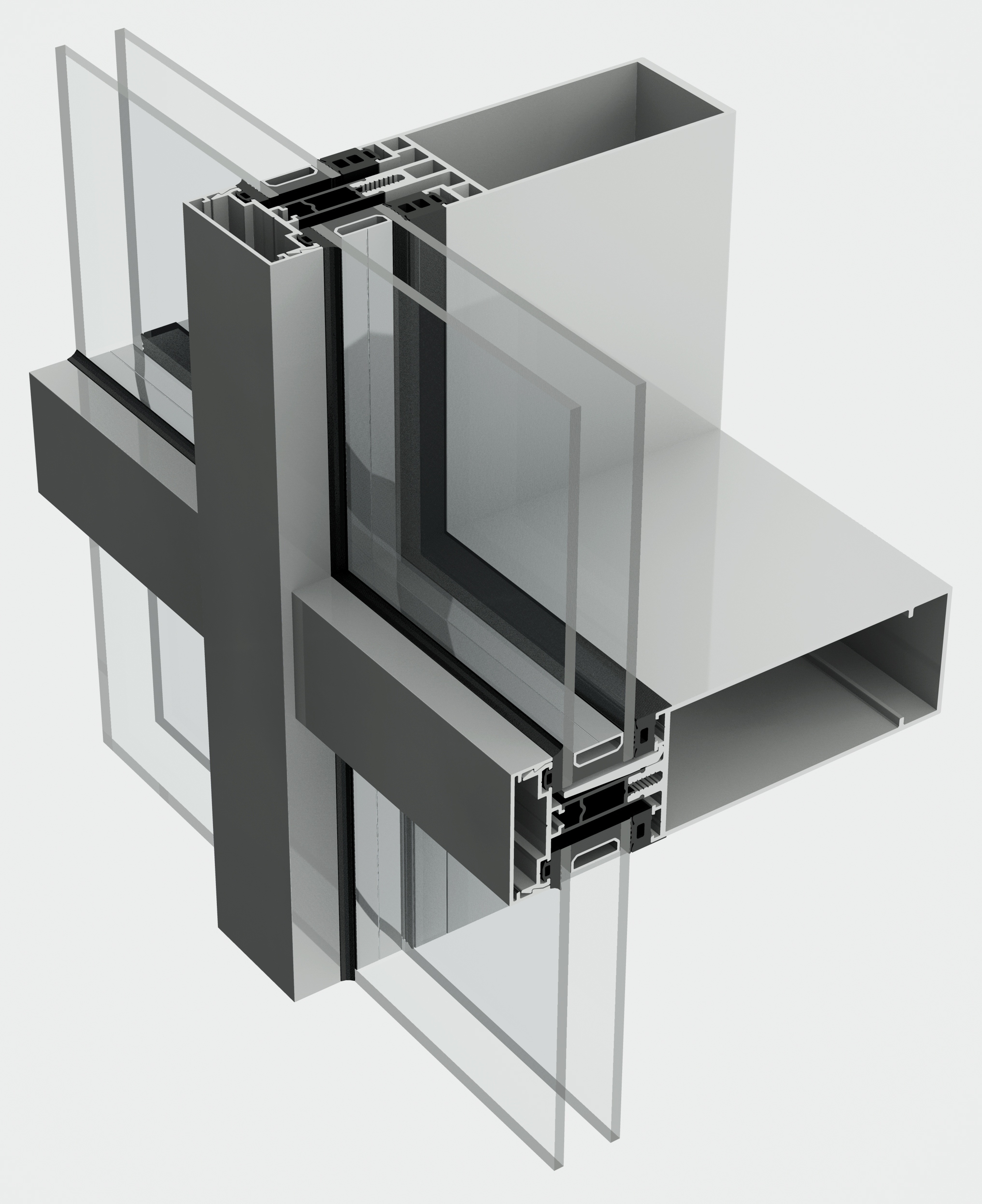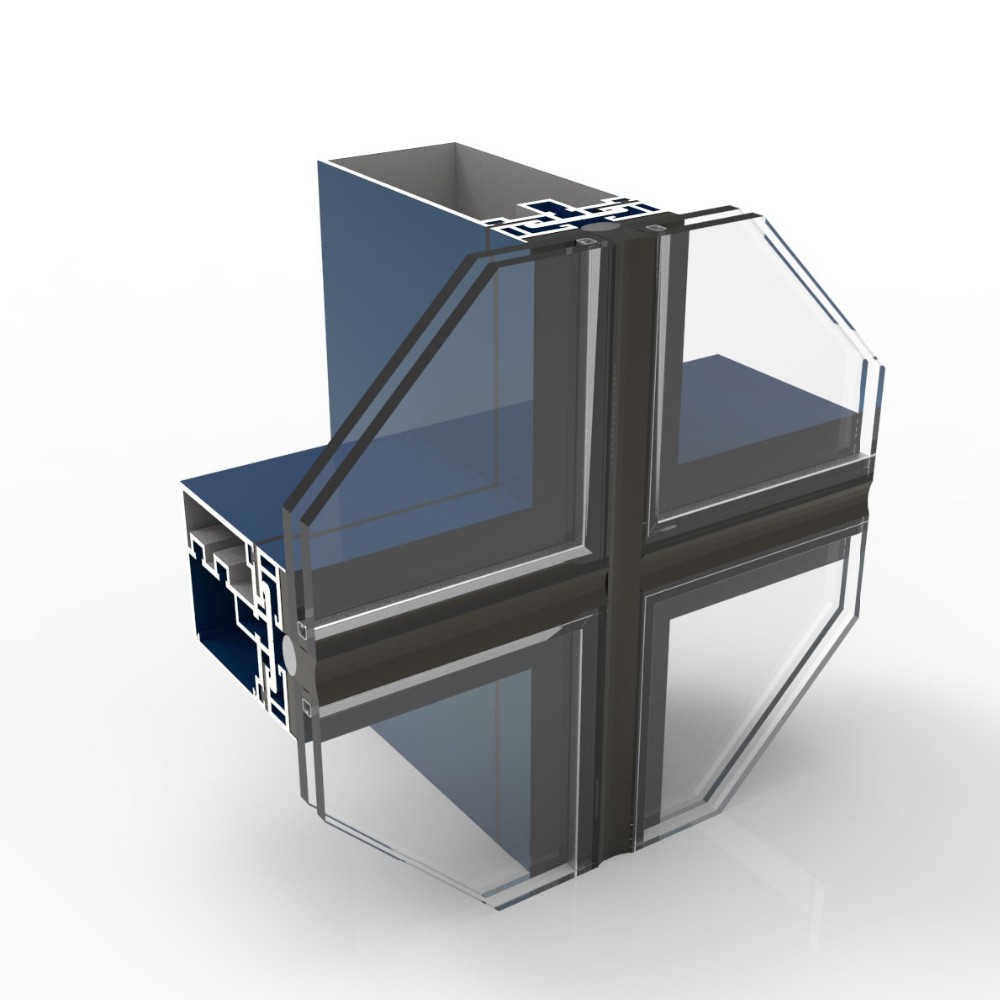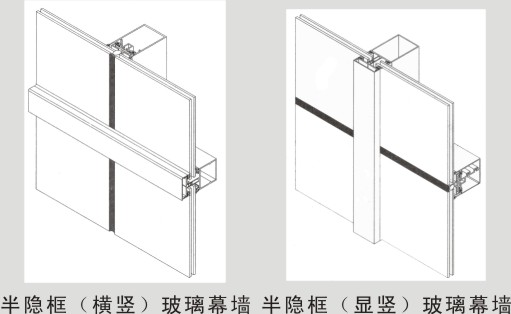3. Aspects of World Folk Culture and Consumption Customs A Curtain Wall system is an outer covering of a building in which the outer walls are non-structural, utilized to keep the weather out and the occupants in. Since the curtain wall is non-structural, it can be made of lightweight materials, thereby reducing construction costs. When glass is used as the curtain wall, an advantage is that natural light can penetrate deeper within the building.
Curtain wall systems are typically designed with extruded aluminum framing members. The aluminum frame is typically infilled with glass, which provides an architecturally pleasing building, as well as benefits such as daylighting. However, the effects of light on visual comfort as well as solar heat gain in a building are more difficult to control when using large amounts of glass infill.
There are frame curtain wall, frameless curtain wall and half frameless curtain wall.
“Folk culture†refers to the community of people with common linguistic qualities, common language, common areas, common economic life, and common culture. Due to the different natural conditions, geographical environments, and political and economic factors of various ethnic groups, various ethnic languages, languages, literature, art, education, science, and other characteristics have gradually emerged. Because the mental qualities of different ethnic groups are different, the living expenses of the various ethnic groups produced are also different.
"Consumption habits" refers to the unity of consumer psychology and consumer behavior. People pay attention to a certain consumer product and become interested in it. When they are satisfied with consumption, they gradually form a hobby for this type of consumer product. They often purchase and use it, thus forming a consumption habit. Therefore, the design of commodity packaging must be different for different regions and countries. It is necessary to pay attention to reflect the national style, but also to respect the customs and likes and dislikes of the consumer groups in the sales region, which is particularly important for export packaging design.
3.1 The export product packaging design should respect the religious beliefs of the sales regions
At present, 60% of the world's population believes in religion. Religious beliefs greatly affect the consumer psychology and lifestyle of people around the world, such as eating, wearing, using, and living. Although packaging workers in China do not necessarily believe in religion themselves, they must understand the significant influence of religion on human life. Whether it is packaging design, advertising language or the use of trademarks, it cannot violate religious taboos. For example, in the Islamic region where pigs are used as trademarks or decorative designs, an import-export company in China sells Panda brand condensed milk to Pakistan. The local area is not popular. After understanding, it is not known that the quality of condensed milk is not good. The problem is that the pattern of panda and pig is relatively poor. Similarly, consumers think this is a shame on Islam. Our people like the panda, a precious animal, and many of its products are branded and decorated with pandas, but they cannot be sold to regions that believe in Islam.
The independent characteristics of ethnic cultures are often related to national consciousness, especially religious beliefs and national lifestyles. For example, the deified packaging formed by the multi-god faith of the Yamato ethnic group in Japan, and the Buddhist religions in Thailand, Burma, India, etc., formed the “Buddha packaging.†What packaging is linked to the “Buddha†and the goods are sold well. If we oppose "Buddha," we will be unsuccessful; Arabs believe in "Allah" and packaging will embody the wishes of "Allah." They will be cheered by consumers. Singapore, on the other hand, has forbidden to use the Buddha's pattern on its packaging because of its beliefs.
There are also many examples of successful use of religious beliefs in the sale of goods. For example, a carpets trader in Belgium knows very well how to use the interactive relationship between religious beliefs and the promotion of goods. He has moved his brain to Muslims. The businessman named Vandeweger has a flat compass embedded in a prayer rug. This special compass is not a guide or a north finger. Instead, he points to the holy city of Mecca. In this way, wherever the Muslims go, they just put carpets on the ground. A shop, Mecca direction can be accurately found immediately. Within a few months, Vandeweger sold a large number of carpets in the Middle East and Africa.
Consumers who believe in Islam prefer the star and the moon pattern, but in the packaging design, they avoid using Xingyue as a graphic. The packaging style should not use other religious images such as Buddha Buddha as a model, otherwise it will make people feel disrespectful and affect the sales. .
Different religious beliefs often have different cultural tendencies and precepts, so if international trade and export goods are not designed and responded when they are packaged, they will often suffer considerable losses.
We use the cross graphic as an example for analysis. From this we can conclude that the same is true because of the different folk cultures and religious beliefs in the world. People's psychological reactions are very different. For example, Tibetan people in China like to use cross patterns to decorate their collars, rims, and uppers to form a chain shape with a variety of colors to create a beautiful pattern. This cross-shaped pattern is very popular in all countries of the world, but the style is different. The cross pattern of Greece is equal on the side, giving a sense of balance; the British Royal Guards cavalry helmets with crosses, said radiant; Christians, It is considered that the "cross" is a symbol of the Holy Spirit and honor and should not appear on the product packaging. In the Buddhist doctrine, the cross represents perfect satisfaction; the cross symbol of Christianity comes from the Latin CRUX and contains the meaning of pain and affliction; the International Red Cross uses crosses to make humanitarian aid symbols. Some scholars have studied this cross symbol of all kinds and said: "The reason that the history of this symbolic symbol is particularly spontaneous is that people believe that the power of the cross symbol can resist evil; the gesture of drawing a cross quickly can drive out the devil and use it as a blackboard. There is also such an effect to write a cross. Here we can see that in the process of creating a certain kind of folk tradition and culture, there are many motives that come together and work.†So it is also a cross symbol that is influenced by all ethnic groups. Loved by others, but there are a variety of different uses and explanations, here does not matter what merits.
The number "13" derived from religious beliefs has always influenced Western folk customs and culture. Westerners are extremely averse to the "13" and Friday figures. They try to avoid it on any occasion. For example, on the 12th floor of a high-rise building, there are 14 floors, and the banquet hall's table 14 is followed by the 12th. Some people are even uneasy about the 13th day of each month. This is because Westerners think that "13" is an unfortunate and dangerous figure. The reason is the “Last Supper†created by the famous Italian painter Da Vinci. Christ Jesus and his disciples were eating together. The 13th person to attend the dinner was Judah. In order to covet 30 silver coins, Judas sold Jesus to Judaism authorities and led the way for those who took Jesus. Jesus was crucified on Friday thirteenth. Westerners hate Judas and also use the number “13†Friday as a symbol of misfortune. This story is widely spread and has a profound impact. So Westerners still regard the number as an ominous "13," and call it Black Friday. The French city house number was replaced with “12A†when it was ranked “13â€; in the United Kingdom, there was a change of new house signboards in the village, and the head of households ranked as “No. 13†was mobilized to court and the result was a victory. Many high-rise buildings in China that accept foreign guests also don’t use the number “13†in order to respect the customs of certain foreign guests. Therefore, our export goods cannot be packaged together with 13 items or with a "13" number.
Europeans think that "7" has a festive color. The Russians like the number 7 and may be related to the Orthodox Church because 7 is favored by God. God created the world in 6 days and rested one day. This is the origin of the week. In Russian, 7 is often used to describe good things. For example, the Chinese say that “think twice before you do it†and the Russians say: “Seven times measure one body at a timeâ€; the Chinese say “Nine Heavensâ€, but the Russians say he is happy to be like “Seven Heavensâ€
The following describes the preferences and taboos of figures in the world as a reference and warning in the design of export goods packaging.
3.2 preferences and taboos for digital and language requirements for export product packaging design
Due to ethnic differences, differences in religious beliefs, and changes in the times, many numbers contain extremely rich connotations and extensions. In the design of export packaging, we must take these figures seriously. For example, the quantity, number and performance of the products contained in small packages in each package must be given special attention and must not be made to the nationalities and people of the country of sale. Otherwise, it will cause unnecessary losses. The customs of the relevant digital section are now described as follows, so that they can be marketed on the export sales package.
3.2.1 preferences and taboos for digital package design of export commodities
The figures are highly regarded in many countries and regions. Residents in many parts of the world also have great superstitions about numbers. Some figures may mean "good luck" in many countries; others may represent unlucky things.
In recent years, a kind of pencil exported from Beijing could not even think of a panic buying phenomenon in the Hong Kong market. The reason for this is because the pencil number is “3388â€. Originally, Hong Kong businessmen thought that "8" was an auspicious number, and "3388" ​​was a homonym in Cantonese which was "a life and a fate" and auspicious for the business.
Residents of certain countries in Asia believe that “4†is unlucky. For example, the "4" in Hong Kong is taboo, because in Cantonese, "4" and "death" are homonyms, so people rarely use "4". When they say "4" is not available, they use "two pairs of Or "two 2" instead;
Japanese people have many language taboos and they are strictly prohibited from using the "4, 6, 9, 42" numbers in their daily friendly gifts and are cautious in packaging design. Since "4" is homonym with "death," the pronunciation of "42" is a dead verb, so hospitals generally do not have 4 and 42 rooms and beds. The user's phone is also jealous of using "42", and the prison generally does not have a No. 4 cell. In Japanese, there is a word related to the pronunciation of "6": "work and nash", meaning "useless person", "outlook", "rogue", etc.; "9" has a pronunciation of "bitter" in Japanese. They often associate "9" with hardship; "13" is also a taboo figure. Many hotels do not have "13" floors and "13" rooms, and Haneda Airport does not have "13" apron. In the United States, there was a group of golf balls that sold poorly on the Japanese market. It was only after investigation that it was known that the problem was on the packaging, because the factory used 4 packages per box. In Japanese, “4†and “death†are homonyms. They are linked together, so the Japanese are not welcome.
Japan is influenced by the idea of ​​auspicious numbers in ancient times in China, and prefers odd numbers. They used odd numbers to congratulate them on festive occasions such as celebrating holidays, wedding ceremonies, and baby names. For example, “7, 5, and 3†are the ages for Japanese children wishing for their children. This is also the number of meals served for the holiday season, namely, 7 on the first dish, 5 on the second dish, and 3 on the third dish. The "three hundred thirty-nine degree" is the figure for the groom and the bride to drink in the wedding ceremony. That is to say, the three bridesmaids will use the three glasses. The groom and the bride will exchange glasses for each cup three times for a total of nine times. In addition to the unavoidable October 10 sports festival, the 12 major festivals in Japan are all odd. Japanese athletes also prefer to use odd numbers. Odd numbers are also favored in Thailand.
When the Japanese gave gifts, they sent gifts in pairs. For example, a pair of pens and two bottles of wine were popular, but when sending newlyweds' red envelopes, they were afraid to send 20,000 yen and a multiple of 2. Japanese folks think that the number is “2â€. Easily lead to emotional breakdown of husband and wife, generally send 30,000, 50,000 or 70,000 yen. When visiting a Japanese family, the chrysanthemums carried can only have fifteen petals, because only the Royal Coat of Arms has sixteen flaps of chrysanthemums. The Japanese give birthdays to the elderly by choosing a certain age. For example, if the 61-year-old is "return calendar", it means that 60 is 1 year old and rejuvenated; 70-year-old is "old"; 77-year-old is "hi-day"; 88-year-old is "mihou" because the Chinese character "m" is opened and changed Into eighty-eight; 99 years old "white longevity", because "white" above the words add a horizontal "hundred." The above figures and folk cultural habits should be the reference for designers in various types of commodity packaging designs sold to Japan.
Koreans are also disgusted with the word "4." Numbers of many buildings are strictly forbidden to have "4" and "4" numbers. When drinking tea and drinking, the owner offers toasts with 1, 3, 5, and 7 odd numbers.
The number of rooms built in Vietnam cannot be double, only 3 and 5 rooms. There were seven singles; when photographing, three people were taken a photo and it was said that people in the middle would be unlucky.
&



Curtain Wall
Curtain Wall,Glass Curtain Wall,Aluminium Curtain Wall,Exterior Curtain Wall
Lingyin Construction Materials LTD , http://www.lingyincn.com